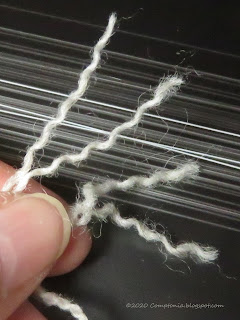The work in progress had a brief hiccup a few days ago, only because math is not my favorite subject. Fortunately I discovered my little miscalculation before knitting an extra acre of garter stitch.
Just a temporary setback.
This Shetland yarn is delightfully "sticky" - in knitters' parlance, the texture is such that a strand of this yarn will lightly grip another strand - so it was quite easy to get 144 live stitches back on the needle: they just sat there nicely, waiting to be picked up. Unlike my usual teeny sock stitches, which disappear into themselves the moment the working yarn is pulled out.
That same sticky quality also makes joining the yarn quite simple. The first step is opening the two plies at the end of each yarn to be joined, and cutting an inch or so from one ply on each end.
One ply on each end to be trimmed,
which reduces the thickness of the joined section.
Next, cross the single plies, fold them back onto themselves, add a few drops of water, and roll the join briskly between palms.
I didn't get a picture of this step because it takes both hands and I was being careful. If anyone is baffled by my description and needs to see it, let me know and I'll set up a couple of shots with demo yarn.
Result.
Onward with the third skein of yarn!
~~~~~



Ooo, I like your join! Especially since dealing with a lot of yarn ends to finish a project is so tedious. Glad the setback wasn't too major!
ReplyDeleteAgree about the weaving in of many ends...that "last step" in a project can delay finishing for a very long time!
DeleteIt's called spit-splicing, if anyone needs to look it up. Works a treat with natural wools.
ReplyDeleteI don't call it that because I don't use spit.
DeleteSome folks call it wet splicing.
DeleteThis comment has been removed by the author.
ReplyDeleteOh! I had no idea about splicing yarn. But it makes sense. Very cool.
ReplyDeleteIt works well with yarn that will felt. Not so much with "superwash" wool, because the process of making it washable removes the same scales that help it stick together in splicing.
DeleteThank you so much for this post. I always tie my ends to the new skein, but hate doing that. I believe that the way you showed us above should work on all yarns. I'm going to give it a try.
ReplyDeleteWorth a try for most wool, I think! Sometimes I tie knots as well, and then weave in the ends. But this yarn has so much "grab" I feel pretty confident that the splice will hold :)
DeleteI just had an eureeka moment! I've known about that method of joining yarn and could never get it to work for me. Adding moisture is the secret....thank you!
ReplyDeleteThank you!
ReplyDeleteNo wonder my splices were so lousy.
I tried to learn how to knit while recovering from my first spine surgery. The "setbacks" were far more numerous than the progress so I eventually gave up. I admire people like you who can do it!
ReplyDeleteMy introduction to knitting - at about 9 years old, a booklet and a pattern for an AFGHAN knit entirely in garter stitch with smallish needles - was actually not so great, and made me feel like a guilty quitter. It was lucky for me that my pal's mother was a lifelong knitter and decided to give her daughter and me some guidance. Our first lesson project was a headband, knit on larger needles, using 2 strands of different-colored yarn held together (oooh! magic!) and we both finished our headbands the same day. Pride! Excitement! I made a THING!
DeleteI learned a lot about teaching, that day - and I've felt grateful for that lesson many times over the years :)